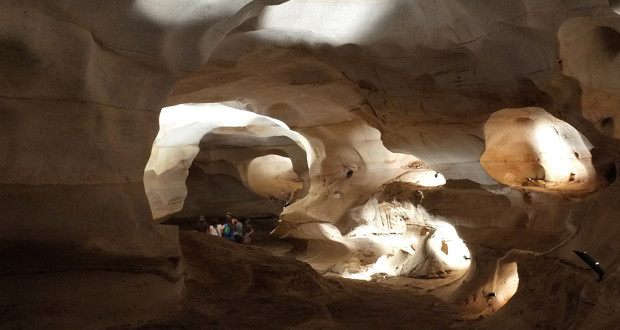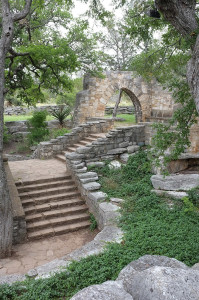The surrounding rock of the cavern originated about 450 million years ago when a tropical sea covered most of Texas. About 300 million years ago, the rock was lifted up with the rest of Central Texas, creating fractures and faults in the limestone that allowed water to flow in. Over millions of years, the water dissolved the limestone and cut the deep underground stream beds in the rock that became Longhorn Cavern.
Once littered with debris, the cavern was excavated during the Depression by the Civilian Conservation Corps, which hauled about 2.5 tons of silt and rock from the caves to make them more accessible. Even today, after particularly heavy rains, parts of the cavern have to be rid of mud.
At one time, the cavern was home to large colonies of bats but they appear to have dwindled to just a few stragglers.
To reach the cavern, you pass through an arch and descend a stone staircase to an atrium created by a window in the rock above. The entrance tends to be a little moist, where the 68 degrees of the cavern meet the 90 degrees of the Hill Country summer.
The path is flat, attractively lit and a pleasant, upright stroll, except for a couple of places where the ceiling dips low. In general, the view gets more impressive the farther in you go, culminating in a series of enormous rooms with gently curving ceilings and walls that are nature’s modern art.
Calcite crystals adorn the walls in a couple of places but the overall experience is less about sparkle and more about texture.
The cavern is open only to guided tours that take about 90 minutes. Friendly guides talk about the geology and sometimes apocryphal history of the cavern, but their greatest value lies in showing you the way in and out of the more than a mile of caves. Special tours are available for photography and geology, along with a “wild cave tour” – not for the claustrophobic – that requires you to crawl on your hands and knees into some very small spaces.
In addition to the cavern, the park’s 645 acres include several short hiking trails available for those waiting around for the next tour.
CAVERN GALLERY









